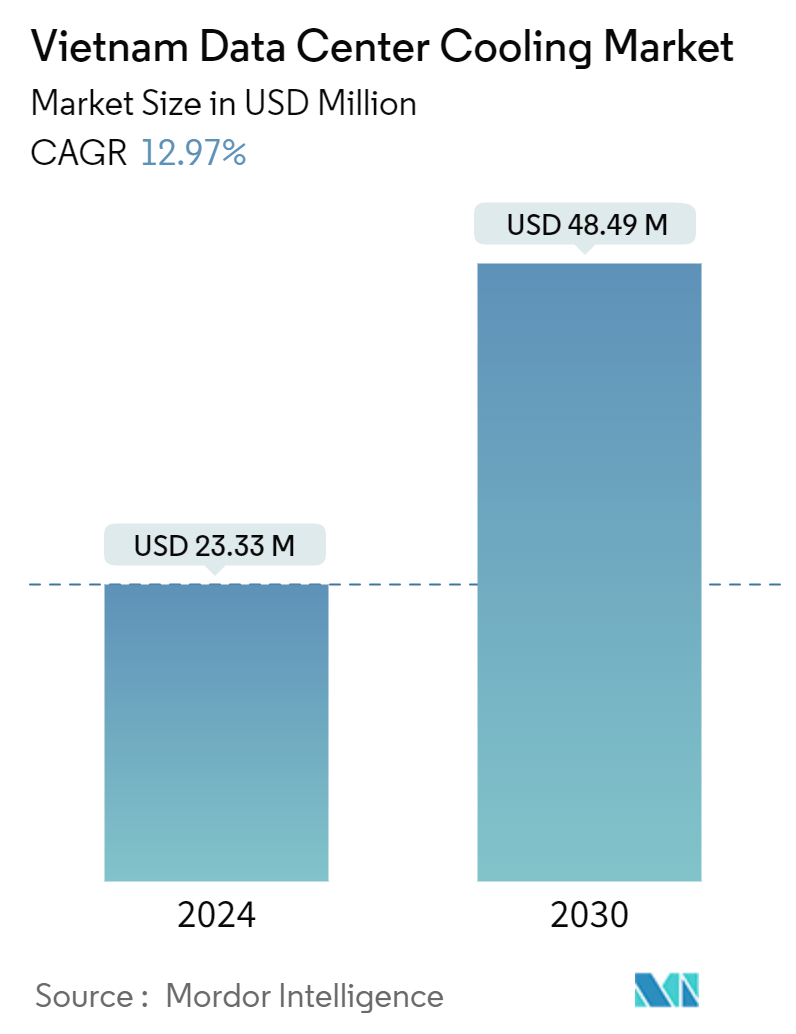Market Size of Vietnam Data Center Cooling Industry

| Study Period | 2019 - 2030 |
| Base Year For Estimation | 2023 |
| Market Size (2024) | USD 23.33 Million |
| Market Size (2030) | USD 48.49 Million |
| CAGR (2024 - 2030) | 12.97 % |
| Market Concentration | High |
Major Players
*Disclaimer: Major Players sorted in no particular order |
Vietnam Data Center Cooling Market Analysis
The Vietnam Data Center Cooling Market size is estimated at USD 23.33 million in 2024, and is expected to reach USD 48.49 million by 2030, growing at a CAGR of 12.97% during the forecast period (2024-2030).
- In Vietnam, the mean annual temperatures are around 24 to 25 °C, in which the coldest month has a mean temperature of 17 to 20 °C and the hottest month has a mean temperature of 29 to 30 °C.
- Extreme weather events are a threat to physical infrastructure such as power stations, electricity cables, and data center buildings, which drives the demand for data center cooling solutions.
- The upcoming IT load capacity of the Vietnamese data center cooling market is expected to reach around 250 MW by 2030. The country's construction of raised floor area is expected to increase by more than 800 thousand sq. ft by 2030.
- The country's total number of racks to be installed is expected to reach 43.9 thousand units by 2030. Ho Chi Minh City is expected to house the maximum number of racks by 2030.
- There are close to 7 submarine cable systems connecting Vietnam, and many are under construction. Vietnam's Ministry of Information and Communications (MIC) approved a strategy to enhance the country's international fiber optic cable system. By 2030, Vietnam aims to add at least ten undersea cables, expanding its undersea routes to a minimum of 15.
Vietnam Data Center Cooling Industry Segmentation
Data center cooling is a system that helps maintain optimal operating temperatures in data center environments. It is critical, as data center facilities house many computer servers and network equipment that generate heat during operation. Efficient cooling systems are used to dissipate this heat and prevent equipment from overheating, ensuring continued reliable operation of the data center. Methods such as air conditioning, liquid cooling, and hot/cold aisle containment are commonly used to control temperature and humidity in data centers.
The Vietnamese data center cooling market is segmented by technology (air-based cooling [chiller and economizer, CRAH, cooling towers, and other air-based cooling technologies] and liquid-based cooling [immersion cooling, direct-to-chip cooling, and rear-door heat exchanger]), type of data center (hyperscale, enterprise, and colocation), and end-user industry (it and telecom, retail and consumer goods, healthcare, media and entertainment, federal and institutional agencies, and other end-user industries). The report offers market sizes and forecasts in terms of value (USD) for the above segments.
| By Cooling Technology | ||||||
| ||||||
|
| By Type of Data Center | |
| Hyperscale (Owned and Leased) | |
| Enterprise (On-premise) | |
| Colocation |
| By End-user Industry | |
| IT and Telecom | |
| Retail and Consumer Goods | |
| Healthcare | |
| Media and Entertainment | |
| Federal and Institutional Agencies | |
| Other End-user Industries |
Vietnam Data Center Cooling Market Size Summary
The Vietnam data center cooling market is experiencing significant growth, driven by the increasing demand for efficient cooling solutions due to rising temperatures and the expansion of data center infrastructure. The country's mean annual temperatures and extreme weather events necessitate robust cooling systems to protect data center operations. The market is further bolstered by the implementation of data localization laws, which have spurred investments from both local and international companies. This regulatory environment, coupled with the growth of the telecommunications sector and the deployment of 5G networks, is fostering a surge in data center construction and the associated cooling solutions. Major players in the market, such as Mitsubishi Electric Corporation, Schneider Electric SE, and Huawei Technologies Co., Ltd., are leveraging strategic collaborations to enhance their market presence and profitability.
The demand for data center cooling solutions in Vietnam is also influenced by the country's digital transformation initiatives and the need for high-bandwidth networking infrastructure. The government's Digital Transformation Program 2025 aims to transition a significant portion of business operations to digital platforms, further driving the need for data storage and cooling solutions. Additionally, the expansion of submarine cable systems and the development of edge data centers are enhancing network connectivity, which is crucial for supporting the growing digital economy. The market is characterized by innovation, with companies like STULZ and OVHcloud introducing advanced cooling technologies that offer environmental and operational benefits. As the market continues to evolve, the focus on sustainable and efficient cooling solutions remains a key priority for industry players.
Vietnam Data Center Cooling Market Size - Table of Contents
-
1. MARKET INSIGHTS
-
1.1 Market Overview
-
1.2 Key Cost Considerations for Cooling
-
1.2.1 Analysis of the Key Cost Overheads Related to DC Operations with an Eye on DC Cooling
-
1.2.2 Comparative Study of the Cost and Operational Considerations Related to Each Cooling Technology Based on Key Factors such as Design Complexity, PUE, Advantages, Drawbacks, and Extent of Utilization of Natural Weather Conditions
-
1.2.3 Key Innovations and Developments in Data Center Cooling
-
1.2.4 Key Energy Efficiency Practices Adopted in Data Centers
-
-
-
2. MARKET SEGMENTATION
-
2.1 By Cooling Technology
-
2.1.1 Air-based Cooling
-
2.1.1.1 Chiller and Economizer
-
2.1.1.2 CRAH
-
2.1.1.3 Cooling Tower (Covers, Direct, Indirect, and Two-stage Cooling)
-
2.1.1.4 Other Air-based Cooling Technologies
-
-
2.1.2 Liquid-based Cooling
-
2.1.2.1 Immersion Cooling
-
2.1.2.2 Direct-to-Chip Cooling
-
2.1.2.3 Rear-Door Heat Exchanger
-
-
-
2.2 By Type of Data Center
-
2.2.1 Hyperscale (Owned and Leased)
-
2.2.2 Enterprise (On-premise)
-
2.2.3 Colocation
-
-
2.3 By End-user Industry
-
2.3.1 IT and Telecom
-
2.3.2 Retail and Consumer Goods
-
2.3.3 Healthcare
-
2.3.4 Media and Entertainment
-
2.3.5 Federal and Institutional Agencies
-
2.3.6 Other End-user Industries
-
-
Vietnam Data Center Cooling Market Size FAQs
How big is the Vietnam Data Center Cooling Market?
The Vietnam Data Center Cooling Market size is expected to reach USD 23.33 million in 2024 and grow at a CAGR of 12.97% to reach USD 48.49 million by 2030.
What is the current Vietnam Data Center Cooling Market size?
In 2024, the Vietnam Data Center Cooling Market size is expected to reach USD 23.33 million.

